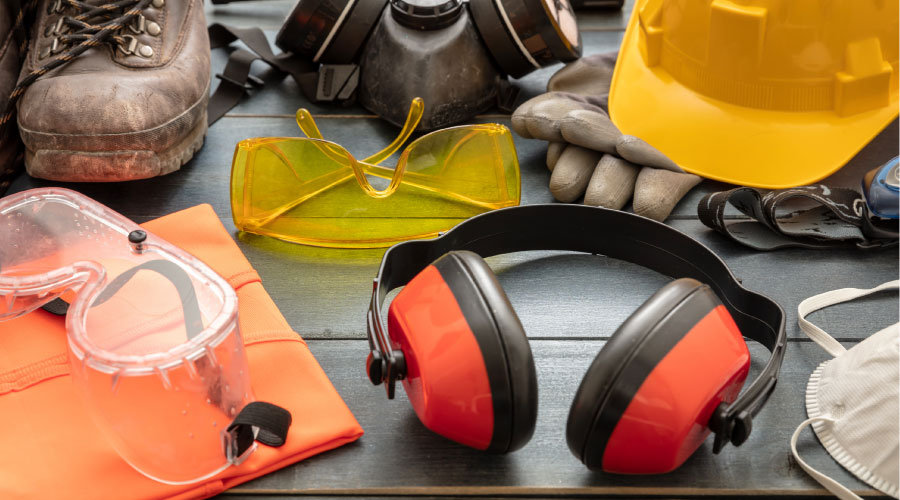Painting the Best Picture
To pick the right paint, look at factors that determine environmental impact, durability and other aspects of performance
Watching paint dry, as the saying goes, doesn’t require much thought or effort. That’s not the case when it comes to choosing and applying paint. A facility executive will want to consider several factors before making the final decision.
For starters, the type of surface to be covered determines which paint will work best. Similarly, different application conditions and environments call for different paints.
If it’s been more than a couple of years since trying “green” or environmentally friendly paints, they should be given another chance. Most have improved dramatically since the earliest versions, and a new category of what’s often referred to as “safety paints” can help protect a facility’s occupants in an emergency or in harsh environments.
Choosing and Applying Paint
The first consideration when choosing paint is the environment in which it will be applied, says Pete Fisher, technical services manager with Rust-Oleum. It is important to consider what daily conditions it will be exposed to, he says. Harsher environments, such as those subject to extremes, severe changes in temperature or high levels of humidity, require more durable paints and coatings. Durability also is critical if the surface may be exposed to chemical spills.
Similarly, application conditions need to be factored in. Some water-based paints and coatings won’t properly cure if applied in colder weather, Fisher says. Some work fine down to 50 degrees F, while others can go as low as 32 degrees F. In addition, different products work best with different application methods, such as brush, sprayer or roller. For example, products that dry quickly tend to work best when sprayed, rather than applied with a brush or roller. Because application with a brush or roller takes longer, this method is best for products that need to cure as they are applied.
Surface preparation also is key; taking shortcuts here can cause even quality paints and coatings to fail, reports the Rohm and Haas Paint Quality Institute (PQI). In addition, properly prepared surfaces enable the paint to adhere more completely, offering better coverage and greater resistance to mildew and corrosion.
For example, if the paint is going over ferrous metal (metal that contains or is made from iron), it’s critical to first remove any loose rust or peeling paint. Primer should be applied as soon as possible after this step, as rust can re-form on a bare surface within a matter of hours. Wood surfaces that haven’t been previously painted, or whose paint has peeled, also should be primed before the paint is applied, according to PQI.
Facility executives also will want to consider the quality of the paint. Cutting corners here can end up costing more in the long run. Higher quality paints offer a greater ratio of solids to liquids, according to PQI. For example, the ratio of solids to liquids in a higher-end paint may be 35 percent solids to 65 percent liquids; in an economy paint, the ratio may be 25 percent solids to 75 percent liquids.
While quality paints typically cost more, they cover better and last longer. Higher-end interior paints are better able to withstand scrubbing and cleaning. They’re also less likely to show brushstrokes, which can be a trap for dirt and mildew. Over time, these attributes can reduce the frequency with which a surface requires repainting, saving both time and money.
It’s equally important to avoid skimping on paint or primer during the application, PQI recommends. Applying a coat that’s too thin may compromise the paint’s ability to protect against mildew, corrosion and cracks.
Green Paints
Green, or environmentally friendly paints, are those that contain either low amounts of or no volatile organic compounds (VOC). While no single definition exists, 50 grams per liter of VOCs is a benchmark used by some third party certification organizations.
Green paints are most often used in facilities that are painted while they’re occupied, such as schools, hotels and hospitals. This is because they don’t emit a noticeable odor, unlike regular paints. “You can apply these in close proximity to people doing their jobs, and they won’t notice,” says Fisher.
In addition, the growing interest in using green paint to help gain LEED (Leadership in Energy and Environmental Design) certification is driving demand, says Jeff Spillane, senior marketing manager with Benjamin Moore.
As a result, the “green paint sector is absolutely growing,” says Pete Donati, director of marketing for commercial segments with Sherwin Williams.
This is a shift from the 1990s, when green paints first came on the market. “Five or six years ago, the concern was that using green paint would sacrifice quality,” says Tom Dougherty, director of brand marketing with PPG Industries, Inc.
In fact, many facility executives and others who worked with the early versions of green paints were less than satisfied with their performance. They often cost more than their non-green counterparts, were more difficult to apply and didn’t cover or hold up as well.
Several factors caused this, says Spillane. One was the removal of glycol, which was used as an antifreeze, from green paints. The other was the elimination of coalescents, which cause latex products to cure. Without these ingredients, the early green paints would freeze and otherwise be unusable, Spillane says. “Application was more difficult and, although the dry time was a bit faster, the cure time was much slower.”
However, advances in technology have improved green paints. Paint manufacturers have developed new polymers, which are the building blocks of paints and coatings, that are more durable and easier to work with, says Donati.
“Most low-VOC paints now have application properties similar to any other product,” says Spillane. Today’s green paints also tend to last about as long as other paints.
As demand for green paints has increased (although it’s still a small fraction of the market), manufacturers’ costs to produce them have dropped, so that they’re now priced similarly to comparable non-green paints and coatings. That holds true both initially, and when the life-cycle cost of the paint is considered, Donati says.
And green paints tend to dry quickly, says Fisher. This has several advantages. For example, Fisher was involved in a project centered on re-painting doorways in a college dormitory. Because the doors couldn’t be closed until the paint had completely dried — otherwise the door and frame would stick together — the college used to have to hire security guards while the doors remained open. That’s no longer the case with green paints. “Now, they can get traffic back in one to two hours,” he says.
That’s not to say that green paints always are the answer. In some environments, paints that contain higher levels of VOCs may hold up better. In the long run, that may mean that they actually emit fewer VOCs into the atmosphere.
Spillane provides an example to illustrate this: A facility executive is painting the floor in a warehouse that is subject to high foot and wheel traffic. It’s likely that a low-VOC paint — say, about 50 grams of VOCs per liter — would require re-painting within a year. On the other hand, a solvent paint that contains 150 grams of VOCs per liter lasts five years. Over that time frame, the solvent paint would actually contribute fewer VOCs to the environment: 150 VOCs to 250 (50 x 5) with the green paint.
In addition, proper surface preparation, while always important, can be even more critical with a water-based (rather than solvent-based) coating, says Fisher. For example, any oil or grease on the surface to be painted must be thoroughly removed before applying an environmentally friendly, water-based paint. “Oil and water don’t mix,” he says.
Exterior Paint
When choosing an exterior paint, three qualities are key, says Lorella Angelini, product segment manager with BASF Building Systems. These are color, texture and the paint’s ability to protect the building from the environment.
Color plays an important role in a facility’s aesthetic appeal, of course. In addition, the facility executive should check that the paint manufacturer has developed a system to ensure that its color remains consistent from one batch to the next, Angelini says. This can be done by providing the base color to distributors, who then mix in the actual color, following strict quality control guidelines. Because the distributor is working more closely with the customer, this process is less likely to lead to errors in the color than if the tint were added at the factory, Angelini says.
Texture refers to the body or thickness of the paint. Paints with a sandy texture, for example, are designed to hold up well even under tough use, Angelini says.
For exterior paints, facility executives will want to check the types of element resistance tests the manufacturer has completed. For instance, one common criteria is that the paint should hold up against windblown rains coming down at 98 miles per hour. Additional tests check how well the paint holds up under either 3,000 or 5,000 hours of ultraviolet rays. Angelini recommends choosing paints that can last for 5,000 hours.
A paint’s ability to hold up against the elements will vary depending on the facility’s location. The weathering that occurs over ten years in a moderate climate may take only three years in a more extreme one. “You have to relate the test to the environment,” Angelini says.
Another consideration is the temperature during the time the paint is being applied. At times, it’s necessary to start or continue a paint job even when the temperatures plummet. If that’s likely to be the case, facility executives need to verify that the paint can be applied effectively even at low temperatures.
SAFETY PAINTS
More Than Just Pretty
Safety paints represent a growing category of paints. These are photoluminescent — in other words, they glow in the dark — paints and coatings that can direct occupants to a facility’s exits when the electricity is out. “They absorb energy from a light source, and when the lights are out, release energy in the form of a glow-in-the-dark coating,” says Pete Fisher, technical services manager with Rust-Oleum.
New York City requires photoluminescent markings in high rise buildings. Other states and municipalities are considering legislation that would make these mandatory in some buildings, he says. For example, they may require at least a strip of photoluminescent coating throughout the length of a stairwell, so that occupants can see their way down the stairs in an emergency.
Another new category consists of anti-slip floor coatings. These provide texture and help prevent slips and falls. Some work when the floor is wet, making them useful in areas like locker rooms.
As with photoluminescent coatings, regulations mandate these in certain areas. Trying to get by with a substitute — such as adding sand to the floor coating — often isn’t effective, Fisher says. The resulting mix of sand and paint simply won’t provide the texture needed to prevent slips when the floor is wet.
|
Karen Kroll, a contributing editor to Building Operating Management, is a freelance writer who has more than 10 years of experience covering real estate and facility issues.
Related Topics:











